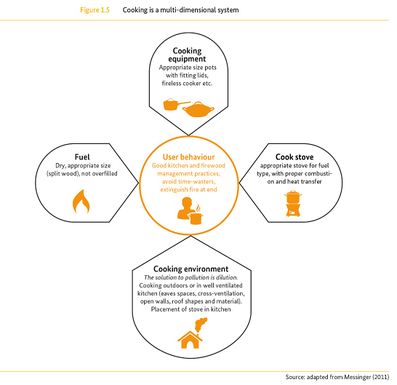Difference between revisions of "The Cooking Energy System"
***** (***** | *****) m |
***** (***** | *****) m |
||
| Line 1: | Line 1: | ||
| + | {{Hera}} | ||
Cooking in households is a complex system, comprising of different factors related to fuel and cooking devices, as well as to user behaviour, cooking equipment and environment (see figure below). Users not only make choices regarding ‘stoves and fuels’, but also make decisions around which meal to prepare, which cooking equipment (pots and pans) to use and, most importantly, how to cook (cooking practices range from high-heat stir-fries to low-heat simmering). The place of cooking, e.g. outdoors, in a well-ventilated space or in a closed kitchen room is a decisive factor on the concentration and dose of harmful cookstove emissions to which people are exposed while cooking. | Cooking in households is a complex system, comprising of different factors related to fuel and cooking devices, as well as to user behaviour, cooking equipment and environment (see figure below). Users not only make choices regarding ‘stoves and fuels’, but also make decisions around which meal to prepare, which cooking equipment (pots and pans) to use and, most importantly, how to cook (cooking practices range from high-heat stir-fries to low-heat simmering). The place of cooking, e.g. outdoors, in a well-ventilated space or in a closed kitchen room is a decisive factor on the concentration and dose of harmful cookstove emissions to which people are exposed while cooking. | ||
| Line 14: | Line 15: | ||
This article was originally published by [http://www.giz.de/fachexpertise/html/2769.html GIZ HERA]. It is basically based on experiences, lessons learned and information gathered by <span data-scayt_word="giz" data-scaytid="58">GIZ</span> cook stove projects. You can find more information about the authors and experts of the original “[[GIZ HERA Cooking Energy Compendium|Cooking Energy Compendium]]” in the [[Imprint - GIZ HERA Cooking Energy Compendium|Imprint - GIZ HERA Cooking Energy Compendium]]. | This article was originally published by [http://www.giz.de/fachexpertise/html/2769.html GIZ HERA]. It is basically based on experiences, lessons learned and information gathered by <span data-scayt_word="giz" data-scaytid="58">GIZ</span> cook stove projects. You can find more information about the authors and experts of the original “[[GIZ HERA Cooking Energy Compendium|Cooking Energy Compendium]]” in the [[Imprint - GIZ HERA Cooking Energy Compendium|Imprint - GIZ HERA Cooking Energy Compendium]]. | ||
| + | [[Category:Cooking_Environment]] | ||
| + | [[Category:Cooking_Fuels]] | ||
| + | [[Category:Cookstoves]] | ||
| + | [[Category:Improved_Cooking]] | ||
[[Category:Cooking_Energy_Compendium_(GIZ_HERA)]] | [[Category:Cooking_Energy_Compendium_(GIZ_HERA)]] | ||
| − | |||
| − | |||
| − | |||
| − | |||
Revision as of 11:38, 27 July 2017
Cooking Energy System | Basics | Policy Advice | Planning | Designing and Implementing ICS Supply | Designing and Implementing Woodfuel Supply | Climate Change | Extra
Cooking in households is a complex system, comprising of different factors related to fuel and cooking devices, as well as to user behaviour, cooking equipment and environment (see figure below). Users not only make choices regarding ‘stoves and fuels’, but also make decisions around which meal to prepare, which cooking equipment (pots and pans) to use and, most importantly, how to cook (cooking practices range from high-heat stir-fries to low-heat simmering). The place of cooking, e.g. outdoors, in a well-ventilated space or in a closed kitchen room is a decisive factor on the concentration and dose of harmful cookstove emissions to which people are exposed while cooking.
In household energy projects, the focus is often directed towards technical solutions, namely the cookstove itself with the respective fuel. In laboratories, well-engineered stoves and fuels have been proven to enhance the performance of cooking energy devices in respect to the heat output, energy efficiency and emissions. However, these positive results don´t often directly translate to actual improvements within households. The focus on stoves and fuels far too often neglects the importance of the user´s capacity to manage fuel, handle the stove, and manage the cooking process in an efficient manner. In short, user behaviour directly influences ‘performance’ within the multi-dimensional cooking energy system.
References
This article was originally published by GIZ HERA. It is basically based on experiences, lessons learned and information gathered by GIZ cook stove projects. You can find more information about the authors and experts of the original “Cooking Energy Compendium” in the Imprint - GIZ HERA Cooking Energy Compendium.





















